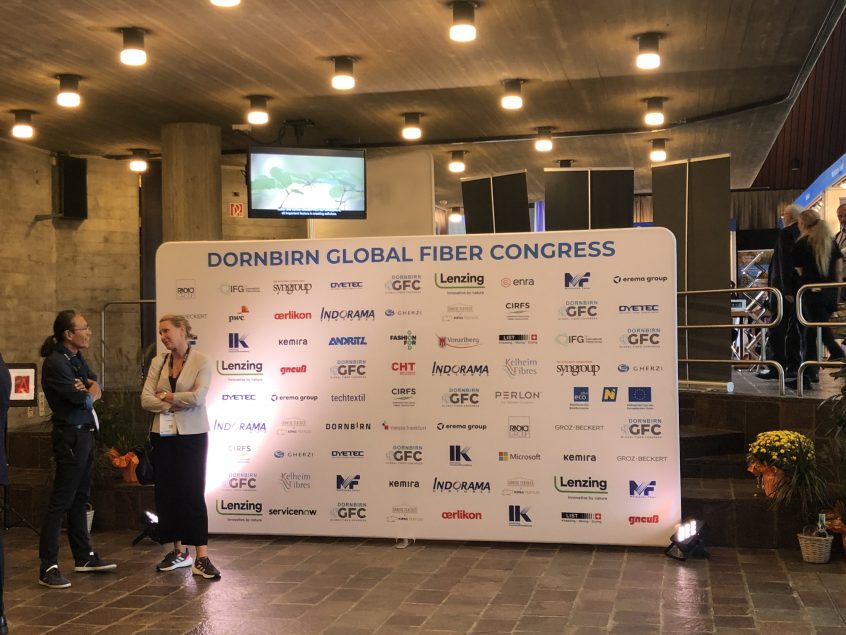The recent Global Fiber Congress in Dornbirn, Austria took place from September 13-15. I had the chance to moderate two interesting sessions. Wednesday afternoon on fiber innovations and Friday morning in the topic apparel & sports. I will report more about the findings of these 10 exciting lectures in a separate post.
„Let us join forces to embrace circularity” is the remaining echo from this year’s three days conference in Dornbirn. More than 550 participants from around 30 countries came to listen to 125 lectures on new topics in fiber innovation & bio materials, circular economy & recycling, sustainability, nonwovens & technical textiles as well as apparel & sports. Not to forget the multiple opportunities for networking between the sessions. Altogether a great record. Thanks to the organizers, Friedrich Weninger, Sonja Spöcker and Lenzing. Not to forget the sponsors Indorama, Märkische Faser, Innovative Kunststoffveredelung, Oerlikon, CIRFS and all contributors of the GFC community.
Less than 1 percent of textile waste is fiber-to-fiber recycled
You know what was the most impressive and thought-provoking figure that I took away from the conference? Up till now less than 1 percent of textile waste is fiber-to-fiber recycled due to several barriers. This is the devastating balance sheet of a recent McKinsey study[1], also cited by the EU Commission. We are generating more than 15 kg of textile waste per person in Europe. The majority derive from garments and home textiles. We all know that incineration and landfills have negative consequences for the environment. With exiting technologies like mechanical and chemical recycling around 70 percent of textile waste could be fiber-to-fiber recycled. This is what purports a Mc Kinsey study. It further estimates that capital expenditure investments of € 6 to 7 billion will be needed to achieve a 18-26 percent fiber-to-fiber recycling in 7 years. We are living in turbulent times full of contradiction and greenwashing slogans that confuse consumers. The only way to more circularity is more transparency for consumers and stronger regulations from official authorities.
There is time for a fundamental change in the textile ecoystem
Despite plenty of overwhelming innovations, new developments and impulses coming from the entire textile value chain, we are apparently still treading water. When will we finally achieve circularity? As Euratex Director General Dirk Vantyghem said in the opening session there is „time for a fundamental change in all industrial ecosystems, including the textile one“. The European Commission has created a sustainable directive for the textile industry by launching the EU Strategy for Sustainable and Circular Textiles to be fulfilled until 2030.[2] The EU Commission’s proposed strategy intends to make “textile products on the EU market by 2030 durable, repairable and recyclable. To a great extent made of recycled fibres, free of hazardous substances, produced in respect of social rights and the environment. Not to forget minimizing incineration and landfilling. Consumers shall benefit longer from high quality affordable textiles. In a competitive, resilient and innovative textiles sector, the circular textiles ecosystem is thriving.” [3] In only 7 years the European Commission intends to change the entire textile ecosystem. Is this feasible at all? And how to prevent a serious production shift to other continents, Asia and Africa?
Global labour force and global players will change in the future
“More than half of the global labour force is in Asia and the Pacific. This share is expected to gradually decline, while the proportion of the global labor force in Africa and the Americas will rise”. One of the breath taking insights that Guiseppe Gherzi, CEO Gherzi Engineering Zurich Ltd. gave in his lecture. The global labor market shift favours delocalization & digitization. According to recent US economic studies Nigeria will range among the top 10 economic powers by 2100. Already today Nigeria is Africa’s largest economy with the biggest population. Two thirds are juveniles. By contrast, the western industrialized countries and China will face an aging population. Against this background Europe needs to get prepared. Among the 125 conference lectures plenty of interesting new solutions, technologies and approaches are offered that show the way to achieve circularity.
[1] https://thesustainableangle.org/eu-strategy-for-sustainable-and-circular-textiles/
[2] https://environment.ec.europa.eu/strategy/textiles-strategy_en#objectives
[3] https://www.mckinsey.com/industries/retail/our-insights/scaling-textile-recycling-in-europe-turning-waste-into-value#/

